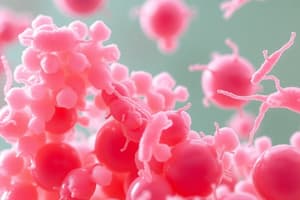Podcast
Questions and Answers
Which of the following is considered a pure substance?
Which of the following is considered a pure substance?
- Iced Tea
- Lemonade
- Salt (correct)
- Water (correct)
Which of the following best describes a compound?
Which of the following best describes a compound?
- A mixture of elements that can be separated physically.
- A type of element that is in its simplest form.
- A homogeneous mixture with varying composition.
- A substance formed from two or more elements chemically combined. (correct)
What distinguishes a heterogeneous mixture from a homogeneous mixture?
What distinguishes a heterogeneous mixture from a homogeneous mixture?
- Heterogeneous mixtures consist of one phase.
- Heterogeneous mixtures have a uniform composition.
- Heterogeneous mixtures are chemically combined.
- Components in heterogeneous mixtures can be visually distinguished. (correct)
Which of the following elements is represented by the chemical symbol 'Cu'?
Which of the following elements is represented by the chemical symbol 'Cu'?
Which of the following is a characteristic of elements?
Which of the following is a characteristic of elements?
Which chemical formula represents water?
Which chemical formula represents water?
What type of mixture is lemonade considered?
What type of mixture is lemonade considered?
Which of the following compounds consists of hydrogen and chlorine?
Which of the following compounds consists of hydrogen and chlorine?
Flashcards are hidden until you start studying
Study Notes
Prayer
- Acknowledgment of the value of education as a daily opportunity for growth.
- Request for divine guidance in using knowledge responsibly and wisely.
Structure of Matter
- Classification of materials is essential to understanding the characteristics of various substances.
- Focus is on identifying which objects have similar characteristics based on their structure.
Objectives
- Classifying matter into distinct categories.
- Differentiating between compounds and mixtures.
- Identifying the components that constitute a compound.
Pure Substances
- Elements like Gold (Au), Silver (Ag), Copper (Cu), Iron (Fe), and Oxygen (O) are examples of pure substances.
- Pure substances can be either elements or compounds.
- Elements consist of only one type of atom, represented by chemical symbols.
Examples of Elements
- Gold (Au)
- Silver (Ag)
- Copper (Cu)
- Iron (Fe)
- Oxygen (O)
Compounds
- Compounds consist of two or more elements that are chemically combined.
- Represented by chemical formulas like:
- Water (H2O)
- Salt (NaCl)
- Muriatic Acid (HCl)
Mixtures
- Mixtures consist of two or more components that are not chemically combined.
- Main types of mixtures include:
- Homogeneous Mixtures: Only one phase; examples include soft drinks and lemonade.
- Heterogeneous Mixtures: More than one phase; components can be visually distinguished.
Common Examples of Mixtures
- Soft Drinks
- Lemonade
- Iced Tea
Characteristics of Mixtures
- Unlike compounds, components of mixtures retain their own properties.
- Solutions represent the most common samples of homogeneous mixtures.
Studying That Suits You
Use AI to generate personalized quizzes and flashcards to suit your learning preferences.



